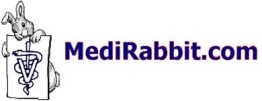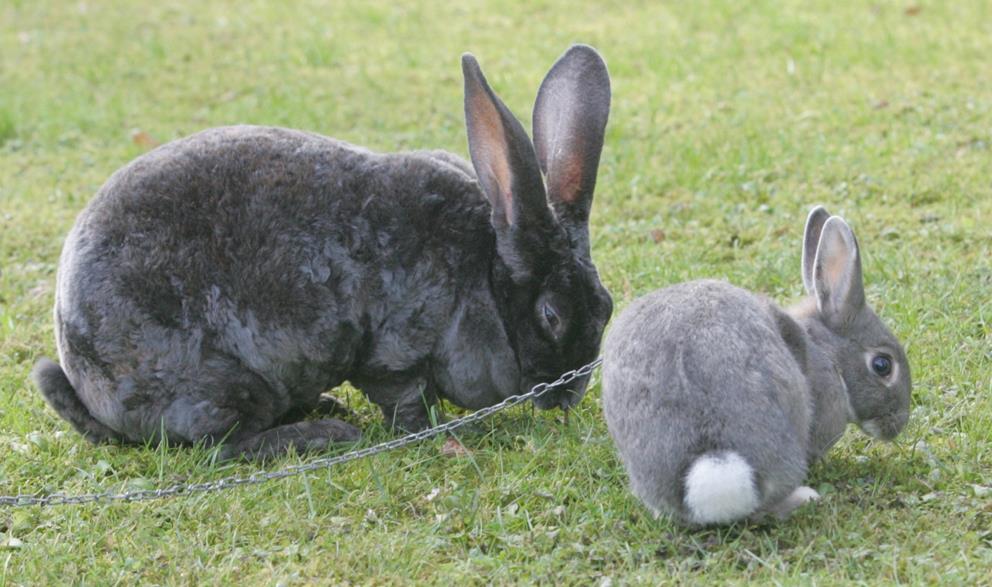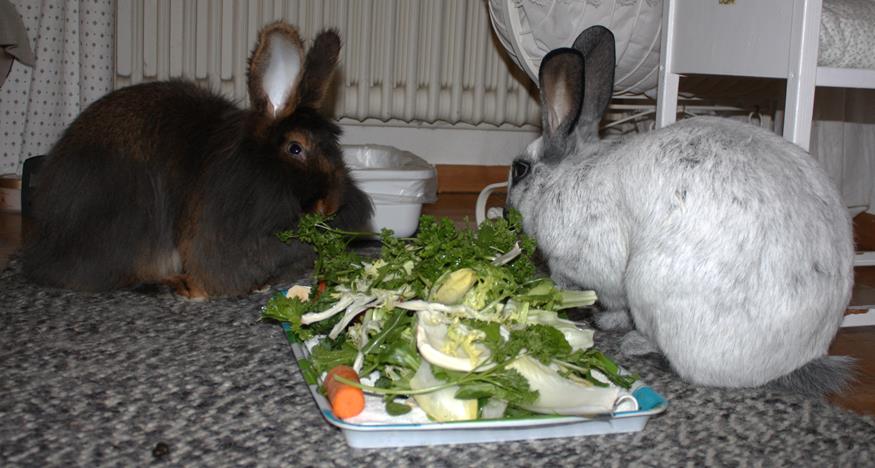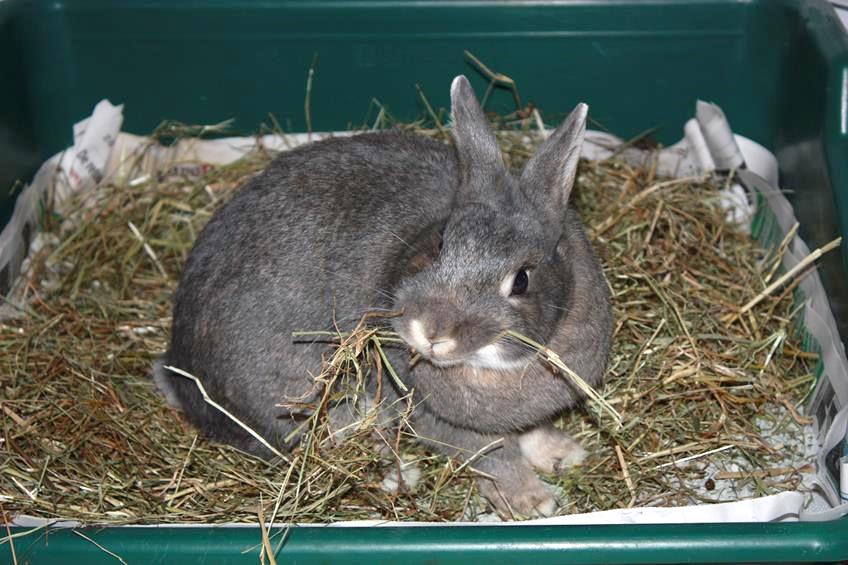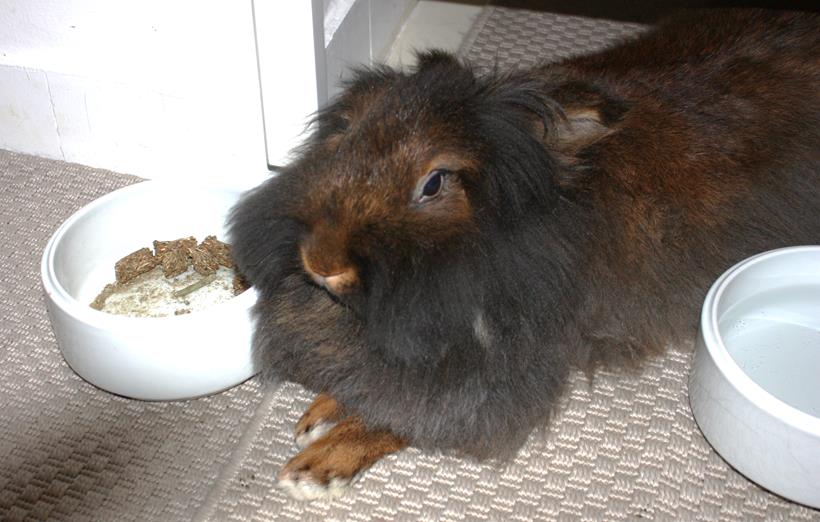Overweight in Rabbits
Esther van Praag, Ph.D.
|
MediRabbit.com is
funded solely by the generosity of donors. Every
donation, no matter what the size, is appreciated and will aid in the continuing
research of medical care and health of rabbits. Thank you |
|
Wild rabbits and hares are only exceptionally
overweight or obese. Their diet is, in fact, varied and balanced and meets
the energy needs of these animals. They lead an active life. Thanks to a
developed musculature, they are able to run quickly, jump, or dig burrows.
Pet rabbits tend to lead more sedentary lives, with little exercise. Lack of
physical activity causes muscle wasting, while they eat a diet that is too
high in calories and too low in fiber. This results in weight gain, even
obesity. Many also receive treats high in sugars and calories. Therefore, pet
rabbits tend to gain weight. The breeding of rabbit breeds has contributed to the
emergence of different physical types. Different forms of the body are
observed according to the races. Some rabbits have elongated, slender bodies,
giving them a slender appearance. Others have larger, shorter and wider
bodies, which can be mistaken for obesity. However, these rabbits are not
obese ... Age of the rabbit must also be taken into account.
Wild rabbits only live a few years on average, while pet rabbits can live 10
years or even longer. Such an increase in age greatly increases the risk of
obesity. Weight gain
and obesity are accompanied by many health problems in rabbits. A rabbit is
considered obese when its ribs are difficult to feel or when the ribs cannot
be detected at all. A very convex rump can also be a sign of obesity in
rabbits.
Causes There are many causes of weight gain in pet rabbits.
There are genetic factors, like in humans. Thus, the dwarf rabbit and the Rex
rabbit, for example, are more susceptible to obesity than other more active
or nervous breeds. There are also metabolic, nutritional and even
emotional factors after the loss of a rabbit companion. Finally, obesity in rabbits is often linked to a
lack of physical exercise accompanied by high-calorie food or the consumption
of overly sweet treats. Of all the causes, this is by far the most common
reason why a rabbit becomes obese. Another cause of obesity is sugary treats. Most rabbits eat what is given to them; it is,
therefore, up to humans to provide them with a healthy diet, appropriate to
the needs of the rabbit, its metabolism and not causing damage to the teeth. Diagnosis of obesity Rabbits are considered obese if they are 20-40%
overweight. There are a number of ways to diagnose obesity. Body condition
scoring is a great help to monitor the weight. To give a rabbit a body
condition score, these steps can be followed. 1. Palpate the
ribs, pelvis, and spine. 2. Measurement and recording of the body weight. Monitoring of the rabbit’s weight is done frequently in order to
see overall trending. Instructions for weighing a rabbit can be found here.
3. Looking up or
asking the veterinarian about the standard weight and body score for the specific breed of rabbits.
Clinical manifestations of
rabbit obesity Overweight promotes the appearance of various
health problems in an affected rabbit such as: Heart
disease: An obese
rabbit can develop various heart and lung conditions, with compression of the
lungs in severe obesity.
Fatty liver
disease: When a rabbit has fat in excess it
can accumulate in the liver. This causes a life-threatening condition known
as fatty
liver disease. Bladder
sludge: Sedentary lifestyle can cause urine to
accumulate in the bladder. The build-up of micro-crystals made of calcium
carbonate in the bladder, causing sludge
that can make urination painful and even block the rabbit's urethra, Diabetes: Obese rabbits can develop diabetes-like
clinical manifestations, characterized by a high level of sugar in the
blood. Treatment includes a correction of the diet and a slow decrease of
weight. No insulin should be given to obese rabbits. Arthritis: More weight and stress on
the joints can cause arthritis
painful and deteriorating joints in obese rabbits. Sore feet: When rabbits carry around too
much weight, they are prone to sore feet. Pododermatitis occurs and cause sores. Bacteria can then enter these sores, which creates an extremely
difficult to treat and painful condition that may put the rabbit at risk
for amputation. Poor grooming
and cecotrophe smearing: Rabbits who are too obese to
turn properly cannot clean themselves well. Some of their fur may not be as
groomed as other parts. Additionally, cecal
smearing—a condition where the cecotropes in a
rabbit’s anus get smeared and hardened on its fur—is common in obese rabbits.
MediRabbit A potbellied
rabbit is not an obese rabbit, rather caused by megacolon (picture) or a
parasitosis like coccidiosis The weight and body score of a rabbit are important factors
that should be checked regularly. If their assessments prove difficult at
home, a veterinarian can help and, if necessary, develop a strict diet to
bring the rabbit back to a normal weight for its age and breed. Treating rabbit obesity Treating rabbit
obesity requires a slow change in habits for both the owner and the rabbit.
The rabbit’s diet
should be rich in fibers (hay or dried herbs). High calorie treats should be
gradually banished and replaced with healthy "treats" like a sprig
of parsley or other aromatic herbs.
MediRabbit Daily fresh
greens is a moment of great pleasure for rabbits Alfalfa,
which is fairly high in protein, is recommended for young and older (sick)
rabbits, while adult rabbits do best with timothy, meadow or orchard hay.
MediRabbit Small rabbit
eating hay Some rabbits
are poor hay eaters. In such a case, dried herbs like plantain, nettle,
dandelion, dried oat stems, or mixes of dried garden herbs and fresh
branches, e.g., fresh willow branches with leaves, offer a good alternative.
MediRabbit Eating hay
makes thirsty Pellets are
recommended too, as they provide a daily minimal amount of nutrients and
minerals that may be absent in hay and fresh vegetables. Pellets should
ideally have between 18-20% fiber and 14-16% protein. MediRabbit A no-pellet
diet can lead to nutritional deficiencies Regular
physical activity is also important in maintaining a healthy rabbit. A rabbit
should not spend its entire day in a cage. Ideally, a pet rabbit should never
live in a cage at all, but rather in a specially furnished room that allows
the rabbit to lead a life at its own pace.
|
||||||
e-mail: info@medirabbit.com

